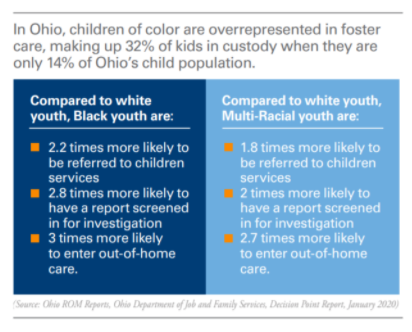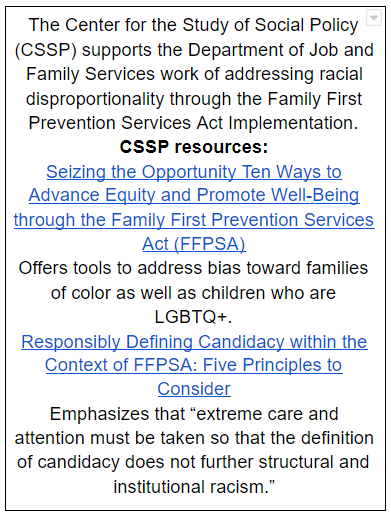 Addressing Racial Bias & Inequity in Child Welfare
Addressing Racial Bias & Inequity in Child Welfare
February 25, 2021
By Kim Eckhart, KIDS COUNT Project Manager
As a community, we have a responsibility to ensure that the systems we have created to protect children from abuse and neglect are free from racial bias. As we confront the awful reality that racial bias permeates all of our systems, including the child welfare system, we owe it to our children to be courageous, humble and honest about the cumulative impact of our individual actions.
The impact is stark and far-reaching. According to a report by Ohio’s Children Services Transformation (CST) Advisory Council: Black and multi-racial children are about two to three times as likely to be referred to children services, to have abuse and neglect reports screened in, and to be placed out of home compared to white children.
We can and must do better for Black and Brown children in Ohio’s child welfare system.
Leaders must ensure that all new child welfare initiatives have racial equity practices embedded in their core mission in order to improve outcomes for all children.
Ohio is currently pursuing several major initiatives designed to improve outcomes for children affected by the child welfare system, including Family First Prevention Services Act (FFPSA) implementation and Kinship Navigators. On their own, these initiatives are not aimed at reducing disparities specifically, so it will take visionary leadership to ensure that steps are taken to include racial equity as a guiding principle.
Ohio has several promising examples of racial equity practices being institutionalized now that can guide shared efforts.
One promising example includes the work of the CST Advisory Council, which released 37 recommendations late in 2020, and states:
 “This effort must begin with raising awareness and creating spaces for honest, transparent conversations about racism and inequities. The voices and experiences of those directly impacted must be at the core of all discussions and transformation planning, with a vision that embraces diversity and inclusion to better serve future generations.”
“This effort must begin with raising awareness and creating spaces for honest, transparent conversations about racism and inequities. The voices and experiences of those directly impacted must be at the core of all discussions and transformation planning, with a vision that embraces diversity and inclusion to better serve future generations.”
The vision for equity outlined in this report specifically highlights a human-centered design project that incorporated the perspectives of foster youth, parents, caregivers, and staff in both Franklin and Lucas counties. Incorporating the voices of those with lived experiences into a human-centered design approach is an important step not only in establishing new initiatives but in re-thinking existing practices – which is a key tenet of unlearning racism and learning how to do the antiracism work across systems. Leaders can create spaces and empower people to be courageous and honest about the role of racial bias in their experiences and practices. When this project is complete, the lessons learned should be shared widely with others in the child welfare system and similar projects should be encouraged and highlighted.
Another example is the racial equity lens taken on by many Ohio leaders as they implement the Family First Prevention Services Act. A racial equity framework is important, because it guides leaders to consider key factors that perpetuate racial inequities as they make important decisions that impact Ohio communities, particularly BIPOC communities. This will be very important for the decisions made about FFPSA implementation. For example, such frameworks hold leaders accountable to questions such as: which evidenced-based prevention services will Ohio select? Do these services show the same level of success with families of color as those who are white? What is the proportion of people of color who provide these specific services?
In this process, leaders must also ensure that when creating an exclusive list of prevention services eligible for FFPSA funding, the list must include practitioners who are Black, indigineous and other people of color. This can be accomplished by empowering practitioners from diverse backgrounds to adopt these specific services or by funding evaluation services so that their preferred methods can be measured for effectiveness and included in the evidenced-based lists.
 CSSP is also providing support to OhioKAN (Kinship and Adoption Navigator) and the Public Children Services Association of Ohio (PCSAO) to provide practical tools like racial impact assessments and training resources. Racial impact assessments guide conversations within institutions using questions like:
CSSP is also providing support to OhioKAN (Kinship and Adoption Navigator) and the Public Children Services Association of Ohio (PCSAO) to provide practical tools like racial impact assessments and training resources. Racial impact assessments guide conversations within institutions using questions like:
- Have you identified the racial/ethnic groups in your jurisdiction?
- For this policy/program/practice, what results are desired, and how will each group be affected?
- What does the data say about different racial and ethnic groups?
It is essential that those completing assessment have an understanding of implicit bias and the history of institutional racism in the child welfare system, as well as a shared language, or an “equity glossary.” CSSP provides training in each of these areas to set the tone for honest assessments.
Leaders across the child welfare system should ensure the effectiveness of racial impact assessments by including the voices of those most impacted, carefully considering the results and changing course if necessary.
Depending on the attitudes of those participating, assessments can be a rote exercise or a meaningful way to engage in a design process. When leaders establish the context for assessments, they have the opportunity to create space for honest conversations that include people impacted by programs. Assessments should be completed with the understanding that changes in a design will likely result. Remaining flexible and open to an iterative design process will lead to meaningful changes.
Those focusing on racial equity in Ohio’s child welfare system should cultivate forums for shared learning and results.
Each of the initiatives mentioned above can learn from the processes, successes, and failures of each other and prior initiatives in Ohio and nationally. Thought leaders on these initiatives should convene to tell their stories and share methods of evaluating success. Common measures will help to identify where disparities are decreasing and where we still need to focus our energies. A coalition of people working to address disparities can lead to greater momentum for change.
CSSP resources:
Offers tools to address bias toward families of color as well as children who are LGBTQ+.
Responsibly Defining Candidacy within the Context of FFPSA: Five Principles to Consider

